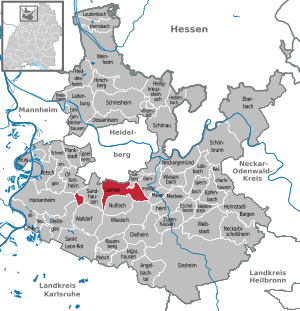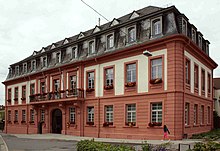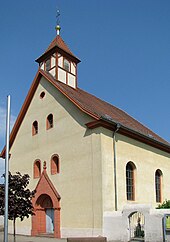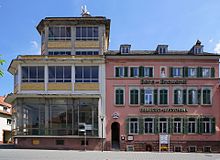Gluing (bathing)
| coat of arms | Germany map | |
|---|---|---|
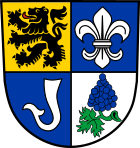
|
Coordinates: 49 ° 21 ' N , 8 ° 41' E |
|
| Basic data | ||
| State : | Baden-Württemberg | |
| Administrative region : | Karlsruhe | |
| County : | Rhein-Neckar district | |
| Height : | 118 m above sea level NHN | |
| Area : | 20.64 km 2 | |
| Residents: | 26,968 (Dec. 31, 2018) | |
| Population density : | 1307 inhabitants per km 2 | |
| Postal code : | 69181 | |
| Primaries : | 06224, 06226 | |
| License plate : | HD | |
| Community key : | 08 2 26 041 | |
| LOCODE : | DE LMN | |
| City structure: | 5 districts | |
City administration address : |
Rathausstrasse 6–8 69181 Leimen |
|
| Website : | ||
| Lord Mayor : | Hans D. Reinwald ( CDU ) | |
| Location of the city of Leimen in the Rhein-Neckar district | ||
Leimen ( ) is a town in northwestern Baden-Württemberg about seven kilometers south of Heidelberg . After Weinheim and Sinsheim, it is the third largest city in the Rhein-Neckar district and, with its surrounding area, belongs to the central Heidelberg area of the regional center of the same name . It belongs to the European metropolitan region of Rhine-Neckar (until May 20, 2003 the Lower Neckar region and until December 31, 2005 the Rhine-Neckar-Odenwald region ).
The municipality of Leimen, newly formed as part of the regional reform of the 1970s, received city rights in 1981 and has been a major district town since 1992 .
geography
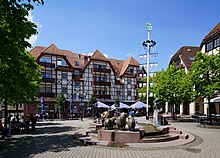
location
Leimen is part of the Rhine-Neckar metropolitan region and is located in the Upper Rhine Plain at the foothills of the Schwetzinger Hardt at the transition to the Kraichgau hill country. The Leimbach flows through the urban area . The Ochsenbach and the Gauangelbach flow in the east of the district .
Neighboring communities
The following cities and communities border the city of Leimen. They are called clockwise starting in the north:
Heidelberg ( independent city ), Gaiberg , Bammental , Mauer , Wiesloch , Nussloch , Walldorf and Sandhausen (all Rhein-Neckar-Kreis ). West of Sandhausen is an uninhabited exclave belonging to Leimen , which is surrounded by the towns and communities of Oftersheim , Sandhausen, Walldorf, Reilingen and Hockenheim .
City structure
The urban area of Leimen consists of the five districts of Gauangelloch , Leimen, Lingental , St. Ilgen and Ochsenbach . The official designation of the city districts is in the form "Leimen- ...", the designation Leimen-Mitte can also be used for the district of Leimen.
Within the limits of September 30, 1973, the hamlet of Ochsenbach belonged to Gauangelloch . Leimen included the hamlet of Lingental (Erhof) , the place Im Industriegelände and the houses Am Kieslochweg, Am Wiesenweg, Baiermühle, Kistenmachermühle, Leimen stop, Lochmühle (Bucheneck), shooting range and Zum Gossenbrunn. The Grauenbrunnen desert is also located here .
history

middle Ages
Leimen was first mentioned in the Lorsch Codex as "Leimheim" in 791 . The name is probably derived from the clay from which the soil in Leimen is largely made thanks to the earlier flood of the Neckar and which, due to its fertility, was probably the reason for the first settlements in prehistoric times.
Both the Lorsch Abbey and the Diocese of Worms owned land. Gauangelloch was mentioned for the first time in 1016, Ochsenbach around 1300, Lingental in 1312 and the town of St. Ilgen in 1341 as St. Aegidius.
In 1262 the local lords of Bruchsal gave the place Leimen to the Count Palatinate as a fief , and from 1351 Leimen finally belonged to the Palatinate . There, Leimen became the seat of the Kirchheimer Zent , which included many neighboring towns west to the Rhine, such as Hockenheim, Schwetzingen, Walldorf, Edingen, Neckarau and, up to the city elevation, also Mannheim.
Modern times
In 1579 the settlement was given the right to hold a fair, and in 1595 the place was designated as a town and market town . In 1674 Leimen was partially burned down during the Dutch War and completely destroyed in 1689 in the War of the Palatinate Succession .
In 1771 a staff holding was set up in Ochsenbach, which was also responsible for the neighboring village of Maisbach, and in 1797 Ochsenbach and Maisbach were raised to the status of a community, to which the neighboring settlement of Lingental was also assigned.
In 1779, Aron Elias Seligmann , who could call himself Baron von Eichthal from 1814, set up a tobacco factory in Leimen, and in 1792 he built a castle in the classical style in Leimen, which today serves as the town hall. His daughter Rebeka Caroline and his nephew Eduard Seligmann, who also came from Leimen, married in 1810 and founded the noble family of Weling .
In 1803 Leimen and the places Gauangelloch, Ochsenbach, Lingental and St. Ilgen fell to the Electorate and Grand Duchy of Baden and became communities in the Lower Office or Landamt Heidelberg, which was combined with the Heidelberg City Office in 1825 to form the Upper Office Heidelberg . However, Gauangelloch first came to the Neckargemünd District Office , then to the Eberbach District Office in 1856 and only to the Heidelberg District Office in 1864 .
20th century
In 1901 Leimen received a tram connection to Heidelberg (see Tram Heidelberg ).
Politically, the commoners in Leimen were leaders until they were replaced by the Social Democrats in 1918 . The SPD remained the strongest party until the end of the Weimar Republic . In 1933, too, it was just able to assert itself ahead of the NSDAP , which received 37 percent of the vote.
In 1937 the community of Ochsenbach was dissolved. The main town came to the municipality of Gauangelloch, the district of Lingental to Leimen and the district of Maisbach to Nussloch. A year later, the Heidelberg district emerged from the previous Heidelberg district office. Some of the Jewish residents of Leimen were deported and murdered during the National Socialist era .
After the end of the Second World War , the social structure of the community changed significantly with the admission of around 1000 displaced persons of German origin from Hungary and what was then Yugoslavia . The Catholic community in particular grew rapidly, and the CDU became the dominant party in the community. In order to remedy the shortage of housing that followed, new building areas were opened up in the 1950s ; In addition, during the years of the West German economic boom, the transition from a rural and small-scale business location to a place of residence for workers and employees who worked outside the city took place. In the 1970s u. a. a new building area on the slope of the Königstuhl, which because of its exposed location became the preferred place of residence of the wealthy population. With the district reform on January 1, 1973, the district of Heidelberg became part of the newly formed Rhein-Neckar district ; In the same year the population of Leimen almost doubled due to the incorporation of the towns of St. Ilgen in the west and Gauangelloch and Ochsenbach in the east on the southern slope of the Königstuhl. During the redevelopment of the town center, which began in 1978, the Georgi market square with cafes and shops was built, and the “Kurpfalz-Centrum” shopping center was built on the site of the tram depot that had become obsolete due to the closure of the tram line to Wiesloch.
In 1981, Leimen was promoted to town. In 1990 the population of the young city exceeded the 20,000 mark. As a result, the city administration applied for a major district town , which the state government then decided with effect from April 1, 1992.
After the departure of the long-time mayor Herbert Ehrbar in 2000, the high level of debt of the municipality became public (as of 2012 around 70 million euros), and investigations revealed numerous financial irregularities in the past few years, and massive planning deficiencies, for example in the construction of the new thoroughfare ( Bürgermeister-Lingg-Strasse, L 600). Due to lawsuits from residents, this could only be opened in 2010 and not in 1999 as planned; in the meantime, however, a bypass has been completed in the north near the old quarry.
Incorporations
The following municipalities or parts of the municipality were incorporated into or combined with the municipality of Leimen:
- 1937: District Lingental of the municipality of Ochsenbach ( Ochsenbach himself came to Gauangelloch, Maisbach to Nußloch)
- October 1, 1973: Gauangelloch (with the Ochsenbach incorporated in 1937)
- May 3, 1975: St. Ilgen (merged with Leimen to form today's municipality of Leimen)
Population development / demography
Population figures according to the respective area. The figures are census results (¹) or official updates from the respective statistical offices ( main residences only ).
|
|
¹ census result
Like many other towns in the Rhine-Neckar region , Leimen’s population today has a high proportion of immigrants ; according to the 2011 census , 41.1% of the Leimen’s population have a migration background . In addition to the guest workers from the very beginning, mainly from Italy and Turkey , there was a large group of Arameans who were persecuted in Turkey for their Christian faith and who therefore left the country. The Arameans, who belong to the Syrian Orthodox Church of Antioch , maintain their religious and cultural tradition in Leimen, so they celebrate their services in the Catholic parish of the Sacred Heart of Jesus (see above) and maintain the sports and cultural association "Aramäer Leimen". In addition, at the beginning of the 1990s, numerous Russian Germans ( late repatriates ) settled in the community, especially in the St. Ilgen new building area Fasanerie, which among other things led to the establishment of a Mix Markt , a German supermarket specializing in Eastern European products.
Religions
Leimen initially belonged to the diocese of Worms and later came to the diocese of Speyer . As in the entire Electoral Palatinate, the Reformation was also introduced in Leimen . The Lutheran creed was first introduced in 1556 , and then in 1559 the reformed creed was adopted. After that, Leimen and the surrounding area were predominantly Protestant communities. From 1699 there was again a separate Lutheran congregation in Leimen. In 1803 the (reformed) Electoral Palatinate came to the (Lutheran) state of Baden and in 1821 the two Protestant churches were united. Since then there has only been one Protestant congregation in Leimen that came to the district of the dean's office (church district) Wiesloch. Since the handover of the St. Aegidius Church to the Catholics in 1707 ( Palatinate church division ), the Protestants of St. Ilgen have also belonged to the parish of Leimen , but the community there received its own church again in 1916 and its own parish in 1930. Since the Reformation, Gauangelloch has been almost exclusively a parish, which was partly also responsible for the neighboring towns. The current Protestant church was built in the neo-Gothic style in 1901/02. The parishes of Leimen and St. Ilgen today belong to the parish of the southern Electoral Palatinate (formerly Wiesloch and Schwetzingen) within the parish of North Baden of the Evangelical Church in Baden . The parish of Gauangelloch belongs to the Neckargemünd church district.
The Catholics who remained after the Reformation did not initially have their own place of worship. It was not until 1707 that they received the Church of St. Aegidius in St. Ilgen as part of the Palatinate church division . In Leimen, the Catholic community was able to build its own church (Herz-Jesu) in 1725, which was replaced in 1914 by the new building of the Herz-Jesu-Kirche , which was built in Art Nouveau style . In Gauangelloch, the Catholics celebrated their services in the rooms of the castle from 1824, before they built their own church (St. Peter) in 1902/04 and received their own parish from 1913. While the Catholics in the Leimen area initially belonged to the Speyer diocese , in 1821/27 they became part of the newly founded Freiburg Archdiocese , where they were assigned to the Heidelberg deanery. In 1976, following the transformation of the Heidelberg deanery into the Heidelberg city deanery, the parishes in the Heidelberg area were divided into neighboring deaneries. The parishes in the area of the community Leimen (Herz-Jesu Leimen, St. Peter Gauangelloch and St. Aegidius in St. Ilgen) thus came to the enlarged deanery Wiesloch , to which they belong to this day. It now comprises a total of 29 parishes. The parishes Herz-Jesu Leimen, St. Peter Gauangelloch and St. Aegidius in St. Ilgen form a pastoral care unit with Sandhausen and Nußloch .
In addition to the two large churches, there are some free churches in Leimen , including the community of Gottes Leimen in the Christian Center Heidelberg / Leimen. In November 2012, the New Apostolic congregation in Leimen merged with its neighboring congregation in Sandhausen. The Baha'i community of Leimen has existed since 1992.
politics
Municipal council
The town council of Leimen has 22 members who hold the title town council and are directly elected every five years. The mayor is also the chairman of the municipal council. The number of seats was initially reduced from 32 to 26 in 2014, as a consequence of the abolition of the phony sub-district selection in 2007. In 2018, the Leimen municipal council decided to reduce the number to just 22 members from the 2019 municipal elections.
Since the local elections in 2019, the municipal council has been composed as follows (in brackets: difference to 2014):
| Political party | be right | Seats |
|---|---|---|
| GALL | 25.1% (+6.0) | 5 (± 0) |
| CDU | 23.9% (−8.4) | 5 (−3) |
| FW | 17.7% (+1.2) | 4 (± 0) |
| FDP | 17.2% (+7.2) | 4 (+1) |
| SPD | 16.0% (−6.2) | 4 (−2) |
The turnout was 49.2% (+11.3).
Until it was abolished in 2014, the urban area was divided into three residential districts in accordance with the Baden-Württemberg municipal code, with the districts of Leimen and Lingental as well as Gauangelloch and Ochsenbach each being combined into one residential district. There were local councils in the three districts . In Gauangelloch and St. Ilgen there is an administrative office of the city administration, which is called the "Citizens' Office".
mayor
At the top of the city, the mayor, since 1992 mayor , who is elected directly by the people for eight years. His permanent representative is the alderman with the official title of mayor . Claudia Felden ( FDP ) is currently mayor. In the Mayor election on March 13, 2016, Hans D. Reinwald (CDU), then Mayor of Graben-Neudorf , was elected with 65.2%. He has been in office since June 11, 2016.
|
|
coat of arms
Description of the coat of arms : The coat of arms of the city of Leimen shows in a quartered shield: 1. A red-tongued, black lion in gold; 2. In blue a silver lily, 3. In blue, a silver fish hook, 4. In silver, a blue bunch of grapes on a green stem with a green vine leaf pointing upwards.
The coat of arms, which was approved in 1981 by the district office of the Rhein-Neckar district, combines the symbols of the earlier coat of arms of Leimen and the current districts of Gauangelloch and St. Ilgen. The Electoral Palatinate lion and the grape were already to be found in the old Leimen coat of arms. The lily was taken from the St. Ilgen coat of arms and the fish hook from the Gauangelloch coat of arms, the latter representing a talking coat of arms. The flag is blue and white.
- Coats of arms of the districts
Town twinning
Leimen has twinning partnerships with the following cities :
- Tinqueux ( France , Grand Est region ), since 1966
- Tigy ( France ), since 1970 with the then municipality of St. Ilgen
- Cernay-lès-Reims ( France ), since 1981 with the Gauangelloch district
- Mafra ( Portugal ), since 1990
- Castanheira de Pera ( Portugal ), since 1993
- Kunín ( Czech Republic ), since 2018
In addition, friendship agreements have existed since the early 1990s. These have a similar character to partnerships, but the exchange takes place less regularly. Agreements were made by the city of Leimen with:
- Meissen ( Saxony )
- Ruda Śląska ( Poland )
- Oktabrskja ( Belarus )
- Krummau ( Czech Republic )
- Elek ( Hungary )
- Alamaskamaras ( Hungary )
- Rodewisch ( Saxony )
There are also so-called sponsorships , which are intended to show the solidarity with the people from this region. The city of Leimen concluded the following sponsorships between 1985 and 1992:
- Mány ( Hungary )
- Hometown groups Almaskamaras and Elek ( Hungary )
- Hometown groups ( Deutsch-Stamora ) and ( Keglewichhausen ) ( Romania )
Neighborhood association
Leimen belongs to the Heidelberg-Mannheim neighborhood association , whose task it is to draw up the regional land use plan.
Culture and sights
Buildings
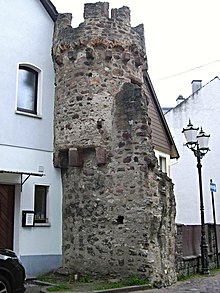
The Franzosenturm in Turmgasse is a remnant of the medieval city fortifications from the 14th century , which were demolished in the 19th century . The original course of the wall is marked with paving stones in Johannisstraße and provided with an information board. The Rösbach used to flow above ground near the tower, which, according to tradition , according to the local historian Georg Menzer, helped the French to penetrate the city because a soldier who had a lover in the city used the opening in the wall as a passage to get to her. When the besiegers discovered this secret, they were able to infiltrate and pillage the city that way . The painter Karl Philipp Fohr made a pen drawing of the tower and its surroundings with the title “The Frankenloch in Leimen”. The picture is in the possession of the Hessisches Landesmuseum Darmstadt . According to information from around 1812 , he also painted a watercolor that was subsequently given the title “The French Hole in Leimen” and is now in the possession of the State Art Gallery in Karlsruhe . Both works show both the tower with the remains of the city wall and the Rösbach flowing past it.
The town hall with mirror hall, the former palace of Aaron Elias Seligmann , later Baron von Eichthal, is the representative building in the city center. The Protestant Mauritius Church was rebuilt in 1681/83 after its destruction and expanded structurally in 1732 and 1932. The Catholic Herz-Jesu-Kirche was only built in 1914.
The St. Aegidius Church is the main attraction in the St. Ilgen district, also because of its romantic location on the Leimbach on a small avenue. The original monastery church has been a Catholic parish church since the Palatinate church was divided in 1707. The Protestant church in St. Ilgen was only built in 1916.
The town hall in the St. Ilgen district has had a porcelain carillon with 13 bells made from Meissen porcelain since 1991 .
In Bettendorff's Castle in Gauangelloch gallery is now housed. The two churches in Gauangelloch date from the beginning of the 20th century and were built in neo-Gothic style, the Protestant church in 1901/02, the Catholic Church of St. Peter in 1902/04.
The historic Lingental estate , which was first mentioned in 1312 and incorporated into Leimen in 1937, is located two kilometers east of the city center on a foothill of the Königstuhl . In the 19th century the estate was owned by the legal scholar Karl Salomo Zachariae , who called himself von Lingenthal after he was raised to the nobility in 1842 . The tombstone of Mogetius, found near the estate in 1884, is one of the most important finds from the Roman era in Leimen. The estate, which consists of six historic buildings and has been connected to a new development area since the 1960s, has been home to several restaurants and businesses since 2013.
The transmitter of the NDB radio beacon NKR is located near the Ochsenbach district.
Sports
- The football club VfB Leimen was founded in 1914 as TV Leimen . 1991/92 he played in the Oberliga Baden-Württemberg.
- TC Blau-Weiß Leimen 1964 eV is a tennis club founded in 1964, which was made famous by Boris Becker from Leimen .
- The weightlifting club AC Germania St. Ilgen currently (as of March 2010) lifts in the 1st Bundesliga. The Federal Association of German Weightlifters and the Performance Center for Weightlifters as a branch of the Rhine-Neckar Olympic Training Center are based in Leimen.
- The cultural and sports community of Leimen is a multi-discipline association founded in 1945. The women's basketball team was German runner-up in 1967 and 1973.
Tourist routes
Leimen is located on three major tourist roads:
- Mountain road that leads from Darmstadt via Leimen to Wiesloch .
- Bertha Benz Memorial Route , from Mannheim via Leimen to Pforzheim and back to Mannheim.
- Baden Wine Route , which leads from Laudenbach via Leimen to Weil am Rhein .
Economy and Infrastructure
Leimen is a wine-growing place rich in tradition , which is also reflected in the city motto “Sport, Wine and European City”. Among the winemakers, the family-owned large company Adam Müller and the Thomas Seeger winery should be mentioned. The brewery founded in 1862 (Bergbrauerei Leimen, beer brand “Bergbräu”, most recently “Leimener”), which was owned by the Geiser family, was closed in 2005 due to a lack of profitability. At the exit of the city in the direction of Heidelberg is the Portland cement plant of HeidelbergCement AG, which has been one of the largest employers in the city since it opened in 1896. Opposite is the company's festival hall, which is now known as the Portland Forum.
traffic
Leimen can be reached via the federal motorway 5 Karlsruhe - Heidelberg (junction Walldorf / Wiesloch or Heidelberg / Schwetzingen ). Bundesstraße 3 Heidelberg - Bruchsal runs between the city center and the St. Ilgen district .
The new north-east bypass L 600 has been connecting the Elsenz valley and the Rhine plain since 2005 with an interesting bridge structure over an old, renatured quarry.
The St. Ilgen / Sandhausen train station is located on the Rhine Valley Railway in the St. Ilgen district . Trains of the RheinNeckar S-Bahn stop here, as well as a few regional and regional express trains. The local public transport (ÖPNV) also serve several bus routes. In 1901 a tram line was opened from Heidelberg via Leimen to Wiesloch. In 1973 the section from Leimen to Wiesloch was closed and replaced by buses. Today tram line 23 of the RNV goes to Heidelberg. Leimen belongs to the tariff area of the Rhein-Neckar transport association .
The Leimen – Nussloch material ropeway is used for freight transport by HeidelbergCement .
Public facilities
Retirement and nursing homes : Dr. Ulla Schirmer House of the Protestant Home Foundation and Pro Seniore Residence Odenwald
education
In Leimen there is a secondary school (Otto-Graf-Realschule), a primary school in Leimen Mitte (tower school), a Werkrealschule with primary school in St. Ilgen (Geschwister-Scholl-Schule) and the primary school Schlossbergschule in the Gauangelloch district.
Leimen runs a music school and a city library.
Personalities
Honorary citizen
Leimen has granted honorary citizenship to the following people :
|
|
sons and daughters of the town
- Aron Elias Seligmann (1747–1824), court financier of the Electoral Palatinate, later Leonhard Freiherr von Eichthal
- David von Eichthal (1775–1850), one of the leading industrialists in Baden
- Simon von Eichthal (1787–1854), banker and large landowner, founder of the Bavarian mortgage and exchange bank
- Joseph Edler von Henikstein (1768–1838), art patron and friend of Wolfgang Amadeus Mozart
- Ferdinand Langer (1839–1905), opera composer and conductor, court conductor in Mannheim
- Daniel Hartmann (1854–1952), worker, found the lower jaw of Homo heidelbergensis
- Leonie Wild (1908–2005), senior boss and co-founder of the Rudolf Wild Works
- Bert Hellinger (1925–2019), family therapist and book author
- Udo Ehrbar (* 1942), politician (CDU), Member of the Bundestag 1983–1994
- Manfred Neuner (1945–2001), football referee
- Rainer Zietsch (* 1964), soccer player
- Jochen Schölch (* 1966), theater director and university lecturer
- Boris Becker (* 1967), tennis player
- Nikias Chryssos (* 1978), film director and screenwriter
- Anne Spiegel (* 1980), politician (Greens)
- Rainer Buhmann (* 1981), chess grandmaster
- Clemens von Grumbkow (* 1983), rugby player
literature
- State Archive administration Baden-Württemberg in connection with d. Cities and districts Heidelberg u. Mannheim (ed.): The city and districts of Heidelberg and Mannheim: Official district description .
- Vol. 1: General part . Karlsruhe 1966
- Vol. 2: The city of Heidelberg and the municipalities of the district of Heidelberg . Karlsruhe 1968
- Kurt Frei: Families in Leimen 1677–1900. Leimen: City of Leimen 1996 (= Badische Ortssippenbücher 77)
- Kurt Frei: Families in St. Ilgen, from 1694. Leimen: City of Leimen 1997 (= Badische Ortssippenbücher 81)
Web links
Individual evidence
- ↑ State Statistical Office Baden-Württemberg - Population by nationality and gender on December 31, 2018 (CSV file) ( help on this ).
- ↑ Main statute of the city of Leimen from February 1, 2001, last changed on July 23, 2009 ( Memento of the original from March 4, 2016 in the Internet Archive ) Info: The archive link was automatically inserted and not yet checked. Please check the original and archive link according to the instructions and then remove this notice. (DOC file; 83 kB)
- ^ The state of Baden-Württemberg. Official description by district and municipality. Volume V: Karlsruhe District. Kohlhammer, Stuttgart 1976, ISBN 3-17-002542-2 , pp. 378-380
- ↑ Minst, Karl Josef [transl.]: Lorscher Codex (Volume 2), Certificate 686, May 1, 791 - Reg. 2315. In: Heidelberger historical stocks - digital. Heidelberg University Library, p. 252 , accessed on February 8, 2016 .
- ^ City history of Leimen on the city's website
- ^ End of a provincial farce: road released after eleven years - mobility. In: Spiegel Online . November 24, 2010, accessed June 9, 2018 .
- ↑ a b Federal Statistical Office (ed.): Historical municipality register for the Federal Republic of Germany. Name, border and key number changes in municipalities, counties and administrative districts from May 27, 1970 to December 31, 1982 . W. Kohlhammer, Stuttgart / Mainz 1983, ISBN 3-17-003263-1 , p. 487 .
- ↑ https://results.zensus2011.de/#dynTable:statUnit=PERSON;absRel=PROZENT;agsAxis=X;yAxis=MIGRATION_KURZ
- ^ Census database - results of the 2011 census. Accessed June 9, 2020 .
- ↑ http://www.nak-heidelberg.de/rueckblick/ereignisseberichte/kirchen district /berichte-de-sued-ka-hd/2012/litzer-gd-leimen /
- ^ State Statistical Office of Baden-Württemberg: Municipal elections 2019, City of Leimen ; City of Leimen: municipal council election 2019 ; accessed June 2, 2019.
- ^ Main statute of the city of Leimen ; accessed June 2, 2019.
- ↑ Since midnight Leimen has had a new town hall chief. Rhein-Neckar-Zeitung, June 11, 2016, accessed on the same day.
- ^ Herwig John, Gabriele Wüst: Wappenbuch Rhein-Neckar-Kreis . Ubstadt-Weiher 1996, ISBN 3-929366-27-4 , p. 73
- ↑ Unofficial title: That's why Leimen is a European city. Retrieved May 25, 2019 .
- ↑ Unofficial title: That's why Leimen is a European city. Retrieved May 25, 2019 .
- ^ LEO-BW: Franzosenturm (Graupfädelpfad, Leimen) . Retrieved February 26, 2017.
- ↑ Website of the city of Leimen: City history # Sights # Franzosenturm ( Memento of the original from February 26, 2017 in the Internet Archive ) Info: The archive link has been inserted automatically and has not yet been checked. Please check the original and archive link according to the instructions and then remove this notice. . Retrieved February 26, 2017.
- ↑ Website of the city of Leimen: "The Frankenloch in Leimen" ( Memento of the original from February 26, 2017 in the Internet Archive ) Info: The archive link has been inserted automatically and has not yet been checked. Please check the original and archive link according to the instructions and then remove this notice. NEWLY DISCOVERED PEN DRAWING BY CARL PHILIPP FOHR. By Karl Ludwig Bansbach. Retrieved April 18, 2017.
- ^ Rolf Kiefer: 1200 Years of Leimen 791–1991, Leimen 1991.
- ↑ William Fischer: Zachariae, Karl Salomo. In: Allgemeine Deutsche Biographie (ADB). Volume 44, Duncker & Humblot, Leipzig 1898, pp. 646-652.
- ^ Rolf Kiefer: 1200 Years of Leimen 791–1991, Leimen 1991.
- ↑ The estate in Lingental is open , in: Rhein-Neckar-Zeitung of September 9, 2013.
- ^ Federal Association of German Weightlifters
- ↑ For the history see: Ferdinand Werner : The long way to new building . Volume 1: Concrete: 43 men invent the future . Wernersche Verlagsgesellschaft, Worms 2016. ISBN 978-3-88462-372-5 , pp. 309-314.

